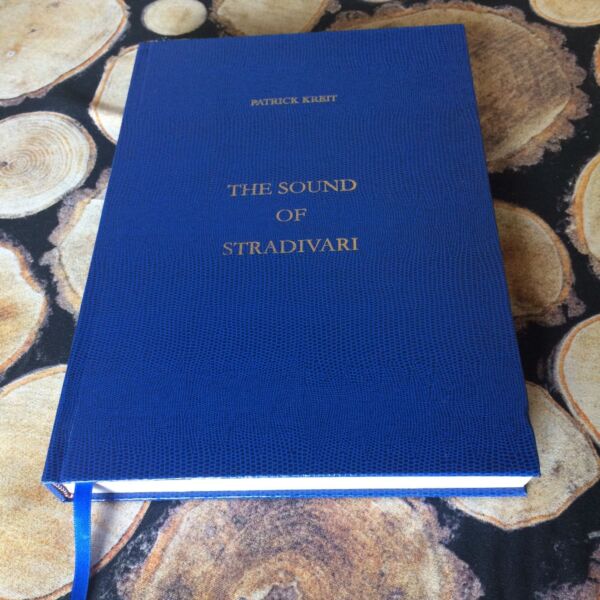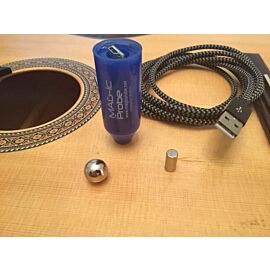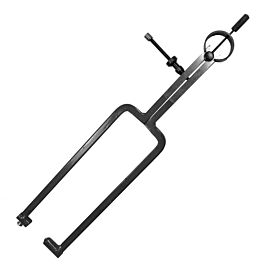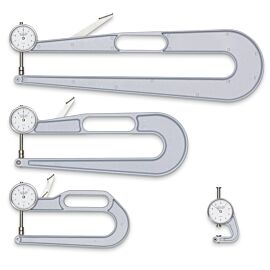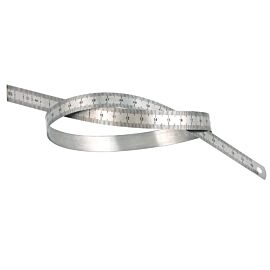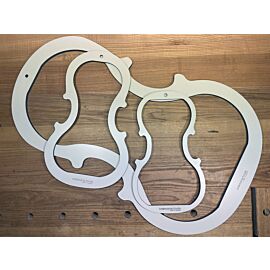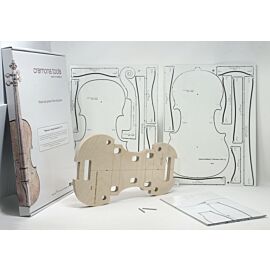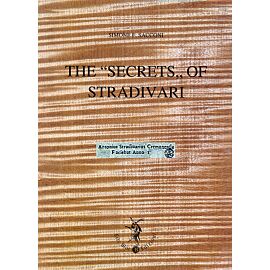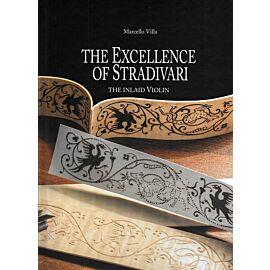€450.00
Out of stock
"The book that everyone has and uses without saying they have it!"
Book on the acoustics and construction of violins for soloists
The “The Sound of Stradivari” Final edition book explaining how to tune mode frequencies 2 and 5 on free back and top plates, modes A0, A1, C2, B0, B1-, B1+ and the various deltas between these modes as well as many important things for the violin maker.
350 pages
ENGLISH TEXT
Book on the acoustics and construction of violins for soloists
The “The Sound of Stradivari” Final edition book explaining how to tune mode frequencies 2 and 5 on free back and top plates, modes A0, A1, C2, B0, B1-, B1+ and the various deltas between these modes as well as many important things for the violin maker.
350 pages
ENGLISH TEXT
Details
The book is accompanied by a CD including software (Windows®) to:
The method of violin plate construction detailed in this book, “The Sound of Stradivari” is the one used by most contemporary violin makers. It consists in entirely finishing the free top and back plates before gluing them onto the rib garland, irrespective of the form used (inside or outside mold).
Two examples explain the procedure for tuning free back and top plates, whatever the violin model.
It is conceived for violin makers (no formulas) in accordance with traditional violin making.
It answers all the essential questions about violin acoustics that a violin maker needs to know.
This very simple tuning technique makes it possible to naturally reproduce arching in the "Italian" style and to understand the genius of Stradivari.
There are different types of violins: soloist, orchestral, chamber music, and student instruments.
These differences are due to the performance of the materials, wood treatments, tuning of the free materials and body modes, the quality of work, and the varnish.
However, designing the outline of a violin model based on perfect geometry and reproducing one of the finest Stradivari or Guarneri instruments will not suffice to obtain excellent sound.
All is vibration; all vibration is a law of physics or acoustics, from the violin to the secret melody of atoms; hence the need to tune the free top and back plates, as well as all of the body modes, to their respective frequencies.
The bow makes the string vibrate, the string makes the violin’s materials vibrate, which in turn sets into motion the air molecules within the body, making it a sound resonator and amplifier.
To replicate the sonority of a classic Italian violin, the violin maker must know these same laws that enabled the creation and perfection of such masterpieces.
Dedicated to the acoustics of the violin, it is accessible to all: professionals, amateurs or beginners.
This book answers several questions:
Several chapters are dedicated to the choice of materials and surface treatments, followed by a synthesis
on heating wood and varnish.
The Italian violin makers at the beginning of the 18th century knew how to recognize a frequency (a beat or a cycle, according to the terms of that era) and knew that the materials’ frequencies followed the moisture content in the wood, which itself followed the ambient humidity. All it takes to realize this is to tap a free violin plate (in the white or varnished) under different conditions of ambient humidity.
Such research constituted the “secret” that has fascinated violin makers and scientists for generations. It is purely a matter of acoustics, since the aim is to reproduce the sonority of the finest Italian violins.
305 photographs show the nodal lines for modes 2 and 5 facilitating their tuning on a top and back plate, both free and assembled separately on the ribs, as well as the tuning of modes A0, A1, B0, C2, B1- and B1+ of a violin in the white.
Each photo is accompanied by the explanations necessary to understand the technique for tuning free top and back plates, as well as the various modes of the sounding box, through the final stringing of the violin in the white.
35 chapters and 44 tables are included in this book.
Recipes for sizing and varnish with explanations concerning the modification of modes B1- and B1+.
Viola and Cello
One chapter is dedicated to the mode 5 frequency of the back and top plates, as well as modes A0, B1-, and B1+ of these instruments. The tuning technique for these modes is identical to that of the violin.
To implement this technique, neither an elasticity tester nor knowledge of the wood’s celerity and elasticity by another means is required. Nevertheless, because the success of a violin depends above all on the choice of materials, select half-plates with the highest tap-tone frequencies (see tables of book).
This solution is simpler and more reliable than a tester, because a high frequency indicates that the wood has high overall characteristics (celerity and elasticity, irrespective of the density). However, moisture content in all the materials must be identical in order to enable comparison.
TEMPERATURE & AMBIENT HUMIDITY
Outdoor temperatures in Cremona can fall below freezing in the winter (-4 °C to -5 °C = 24.8/23 °F) with 10% moisture in the air. Moisture content in the wood drops naturally to between 2% and 1.5%. Ambient humidity can also drop to 10% in the summer or during a drought, or rise to 95% during periods of high humidity. The moisture content in the wood can increase to as much as 13.5%. The same is true for North America and Europe, with 0% moisture content in the wood when the temperature outside drops to -15 °C (5 °F) and even lower, as for example, in Finland (-25 °C = -13 °F).
A personal electronic weather station will make you aware of significant, rapid changes in ambient humidity and allow you to anticipate a significant, rapid change in the moisture content in the wood during the tuning process.
The frequency problems related to the wood’s hygroscopic instability could not have been unknown to the Italian craftsmen. Without modern technical means, they nevertheless had the possibility of using a simple method, consisting in tuning: a) without hollowing the intrados, the starting volume of a back plate and a top plate to a specific note, corresponding to a determined moisture content in the wood; and b) “model plates” (i.e., a pre-finished free top and back plate before cutting the f-holes).
This book is the result of 42 years of research on the acoustics of the violin, viola, cello, and on varnish. All mode frequencies were studied to their critical limits (upper and lower).
This work provides all the necessary explanations regarding the behavior of the materials, according to their characteristics and moisture content, in order to properly tune the mode 5 of the free materials, with optimized weight.
- calculate the A0 cavity mode,
- calculate density of the tonewood,
- calculate moisture content in the wood.
- An 8-minute video demonstrates how to monitor the A0, A1, C2, B0, B1-, B1+, mode frequencies and how to read frequency peaks using Audacity.
- Stradivari and Guarneri PDF forms.
- Spreadsheet with mode frequencies B1- and B1+ of 18 Stradivari and 13 Guarneri violins.
The method of violin plate construction detailed in this book, “The Sound of Stradivari” is the one used by most contemporary violin makers. It consists in entirely finishing the free top and back plates before gluing them onto the rib garland, irrespective of the form used (inside or outside mold).
Two examples explain the procedure for tuning free back and top plates, whatever the violin model.
It is conceived for violin makers (no formulas) in accordance with traditional violin making.
It answers all the essential questions about violin acoustics that a violin maker needs to know.
This very simple tuning technique makes it possible to naturally reproduce arching in the "Italian" style and to understand the genius of Stradivari.
There are different types of violins: soloist, orchestral, chamber music, and student instruments.
These differences are due to the performance of the materials, wood treatments, tuning of the free materials and body modes, the quality of work, and the varnish.
However, designing the outline of a violin model based on perfect geometry and reproducing one of the finest Stradivari or Guarneri instruments will not suffice to obtain excellent sound.
All is vibration; all vibration is a law of physics or acoustics, from the violin to the secret melody of atoms; hence the need to tune the free top and back plates, as well as all of the body modes, to their respective frequencies.
The bow makes the string vibrate, the string makes the violin’s materials vibrate, which in turn sets into motion the air molecules within the body, making it a sound resonator and amplifier.
To replicate the sonority of a classic Italian violin, the violin maker must know these same laws that enabled the creation and perfection of such masterpieces.
Dedicated to the acoustics of the violin, it is accessible to all: professionals, amateurs or beginners.
Generator or software:
both techniques, each with its advantages and drawbacks, can be used concurrently. Computer (desktop, portable, tablet, or phone) equipped with sound analysis software. Back plate and top plate can all be tap-tuned by using audio-capture software such as Audacity (free).This book answers several questions:
- How to tune the frequency of modes 2 and 5 of the back and top plates violin ?
- How to select a bass bar in order to raise the top plate's frequency after cutting the f-holes?
- How to tune the frequency of modes B1- and B1+ ?
- How to tune the A0 cavity frequency "without sound post," on which the A1 mode frequency also depends?
- How to tune the B0 mode frequency with the A0 cavity frequency "with sound post"?
Several chapters are dedicated to the choice of materials and surface treatments, followed by a synthesis
on heating wood and varnish.
The Italian violin makers at the beginning of the 18th century knew how to recognize a frequency (a beat or a cycle, according to the terms of that era) and knew that the materials’ frequencies followed the moisture content in the wood, which itself followed the ambient humidity. All it takes to realize this is to tap a free violin plate (in the white or varnished) under different conditions of ambient humidity.
Such research constituted the “secret” that has fascinated violin makers and scientists for generations. It is purely a matter of acoustics, since the aim is to reproduce the sonority of the finest Italian violins.
305 photographs show the nodal lines for modes 2 and 5 facilitating their tuning on a top and back plate, both free and assembled separately on the ribs, as well as the tuning of modes A0, A1, B0, C2, B1- and B1+ of a violin in the white.
Each photo is accompanied by the explanations necessary to understand the technique for tuning free top and back plates, as well as the various modes of the sounding box, through the final stringing of the violin in the white.
35 chapters and 44 tables are included in this book.
Recipes for sizing and varnish with explanations concerning the modification of modes B1- and B1+.
Viola and Cello
One chapter is dedicated to the mode 5 frequency of the back and top plates, as well as modes A0, B1-, and B1+ of these instruments. The tuning technique for these modes is identical to that of the violin.
To implement this technique, neither an elasticity tester nor knowledge of the wood’s celerity and elasticity by another means is required. Nevertheless, because the success of a violin depends above all on the choice of materials, select half-plates with the highest tap-tone frequencies (see tables of book).
This solution is simpler and more reliable than a tester, because a high frequency indicates that the wood has high overall characteristics (celerity and elasticity, irrespective of the density). However, moisture content in all the materials must be identical in order to enable comparison.
TEMPERATURE & AMBIENT HUMIDITY
Outdoor temperatures in Cremona can fall below freezing in the winter (-4 °C to -5 °C = 24.8/23 °F) with 10% moisture in the air. Moisture content in the wood drops naturally to between 2% and 1.5%. Ambient humidity can also drop to 10% in the summer or during a drought, or rise to 95% during periods of high humidity. The moisture content in the wood can increase to as much as 13.5%. The same is true for North America and Europe, with 0% moisture content in the wood when the temperature outside drops to -15 °C (5 °F) and even lower, as for example, in Finland (-25 °C = -13 °F).
A personal electronic weather station will make you aware of significant, rapid changes in ambient humidity and allow you to anticipate a significant, rapid change in the moisture content in the wood during the tuning process.
The frequency problems related to the wood’s hygroscopic instability could not have been unknown to the Italian craftsmen. Without modern technical means, they nevertheless had the possibility of using a simple method, consisting in tuning: a) without hollowing the intrados, the starting volume of a back plate and a top plate to a specific note, corresponding to a determined moisture content in the wood; and b) “model plates” (i.e., a pre-finished free top and back plate before cutting the f-holes).
This book is the result of 42 years of research on the acoustics of the violin, viola, cello, and on varnish. All mode frequencies were studied to their critical limits (upper and lower).
This work provides all the necessary explanations regarding the behavior of the materials, according to their characteristics and moisture content, in order to properly tune the mode 5 of the free materials, with optimized weight.


